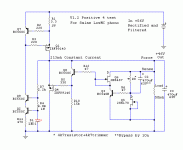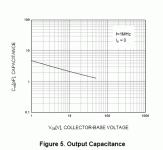It still seems to be a good option for higher voltage though, when you choose between higher Cob transistors with high Vce (though I haven't specifically looked on the exact affects of Cob at this position yet). (on that note, higher voltage makes R8 become bigger, which again decreases the load on the VAS)
I wouldn't know what the affects would be of the transistor operating on 1.5V Vce. The simulator doesn't show much, but I've been told the simulator doesn't model this affect. What I do know is if the gate resistor is large, fast transients might cause Q1 to saturate Vcb (of course by then I would also worry about J1 in my schematic not having enough bias voltage).
- keantoken
I wouldn't know what the affects would be of the transistor operating on 1.5V Vce. The simulator doesn't show much, but I've been told the simulator doesn't model this affect. What I do know is if the gate resistor is large, fast transients might cause Q1 to saturate Vcb (of course by then I would also worry about J1 in my schematic not having enough bias voltage).
- keantoken
It's definitely something I'd try for high voltage, such as used in tube circuits 100V and up. I used to have a cascode of two NPNs, but your solution would work better I think. For less than 50V I'd stay still with the board as is, because of the flexibility it offers to go from 3V all the way up to possibly 60V, or even higher, if the right Q1 is chosen.
It still seems to be a good option for higher voltage though, when you choose between higher Cob transistors with high Vce (though I haven't specifically looked on the exact affects of Cob at this position yet). (on that note, higher voltage makes R8 become bigger, which again decreases the load on the VAS)
- keantoken
I am using a big RL and just Vgs margin for the BJT too in something I am thinking to test for my new low MC phono build that needs high enough B+
My considerations are if I can make it with very common, not super fast parts, that will not oscillate in practice with potent but slow PMOS that I like. It could go IRF9610, but the Ygfs is skinny. OTOH with IRFP9140 I am afraid it will be difficult for stability in practice.
Attachments
One thing to consider is that although high Vce transistors tend to have higher Cjo, Cjo can get much smaller with higher Vce. So it's worth looking at the Cj curves on the datasheet, if they are provided.
- keantoken
- keantoken
Salas, I like your new circuit. It should have very good line regulation, and the output impedance is outstanding. You should probably not worry about instability unless it proves to be so in practice. I'll get back to you later about the other things we discussed.
Remains to be breadboarded. Now I got my R-Core 21+21 to wire in series. From the charts above it also shows that when using higher Vce buffer transistor in your reg for higher B+ circuits like my phono, it actually gets even faster, Cob drops. So I could test yours on the phono too. Swell.
Hi Iko,
Only for fun, Erno's series reg.
Are very good only 5uV noise😉
When do your reg. I compare with Erno's reg. I believe is a very good point to start.
Only for fun, Erno's series reg.
An externally hosted image should be here but it was not working when we last tested it.
Are very good only 5uV noise😉
When do your reg. I compare with Erno's reg. I believe is a very good point to start.
A very good point to start? I think you're making fun of me 😀 We're talking about Erno, now I'm scared! We can't beat Erno!
regarding Borbely
He have been using (since i remember ) in his shunt regulators a smal film capacitor (100nF MKP1837 ) just after the Mosfet CCS
Could it bring any benefits also in "our"😉 Shunt Regulator ?
He have been using (since i remember ) in his shunt regulators a smal film capacitor (100nF MKP1837 ) just after the Mosfet CCS
Could it bring any benefits also in "our"😉 Shunt Regulator ?
A very good point to start? I think you're making fun of me 😀 We're talking about Erno, now I'm scared! We can't beat Erno!
That's Erno SERIES regulator, a Shunt can beat it 🙂
regarding Borbely
He have been using (since i remember ) in his shunt regulators a smal film capacitor (100nF MKP1837 ) just after the Mosfet CCS
Could it bring any benefits also in "our"😉 Shunt Regulator ?
Do you mean from S to GND? Is it close to the CCS mosfet on the board?
Erno's shunt reg. +-5V for digital is better than his series reg. reach only 1uV noise.
Iko only post the pic for fun, not to compare Erno's work with your work, but if your work is near Erno's work, will be a great success for DIY community.
Iko only post the pic for fun, not to compare Erno's work with your work, but if your work is near Erno's work, will be a great success for DIY community.
Erno's shunt reg. +-5V for digital is better than his series reg. reach only 1uV noise.
Iko only post the pic for fun, not to compare Erno's work with your work, but if your work is near Erno's work, will be a great success for DIY community.
😀
Wow! 1uV noise? I can't even measure 1uV. I have great respect for Erno's work, I don't even dare compare what we do here with his work.
However, with respect I say that I would like 1uV with my own eyes, measured. I think in reality even GND in most places has more noise than 1uV. But I'm just a hobbyist so my opinion doesn't carry much weight, and I'm perfectly happy that way. 😀
I also like Erno's work 🙂
Merlin do you know how specs the high-voltage (20-30) shunt reg? And also how it behaves vs current (one thing i really like in Iko design is this, which allows me to try on the psu for the output stage).
Merlin do you know how specs the high-voltage (20-30) shunt reg? And also how it behaves vs current (one thing i really like in Iko design is this, which allows me to try on the psu for the output stage).
see on the attached pictures (those caps in the red circles)
That's not a series reg., also is not a shunt reg., is an All Fet reg. like the same that I have in mine I/V & mine pre-amplifier, but I am always using teflon board + BG.
merlin, how much improvement have you found from using teflon PCB material? I would expect damping to be far superior and of course the better dielectric constant. but I do wonder about blackgates, I do like the nonpolar and FK series, but i'm not sure they are better than Nichicon KZ or sanyo OSCON from my experience. I still have some FK left to try in these regs, but i'm not sure I will bother buying more with the price they are now, i'm not sure they are even better, let alone THAT much better.
i'm interested in using teflon for my dac, possibly with silver immersion for ultra wank factor 😀 I like silver in digital circuits alot. it will be quite a bit extra and it would be great if you could give me your impressions vs high quality non-PTFE PCBs. perhaps PM would be better, rather than taking this thread off course.
so how close are we to this order ikoflexer? I might grab a few with bundled parts if you end up doing that, but not all as I want to try out a few combinations of parts. I may also up my order to 11 and bring the price down, who knows when these will be available again and a friend here has expressed some interest in a coupe pre-built ones I will make him.
i'm interested in using teflon for my dac, possibly with silver immersion for ultra wank factor 😀 I like silver in digital circuits alot. it will be quite a bit extra and it would be great if you could give me your impressions vs high quality non-PTFE PCBs. perhaps PM would be better, rather than taking this thread off course.
so how close are we to this order ikoflexer? I might grab a few with bundled parts if you end up doing that, but not all as I want to try out a few combinations of parts. I may also up my order to 11 and bring the price down, who knows when these will be available again and a friend here has expressed some interest in a coupe pre-built ones I will make him.
- Status
- Not open for further replies.
- Home
- Amplifiers
- Power Supplies
- My take on a discrete shunt voltage regulator


